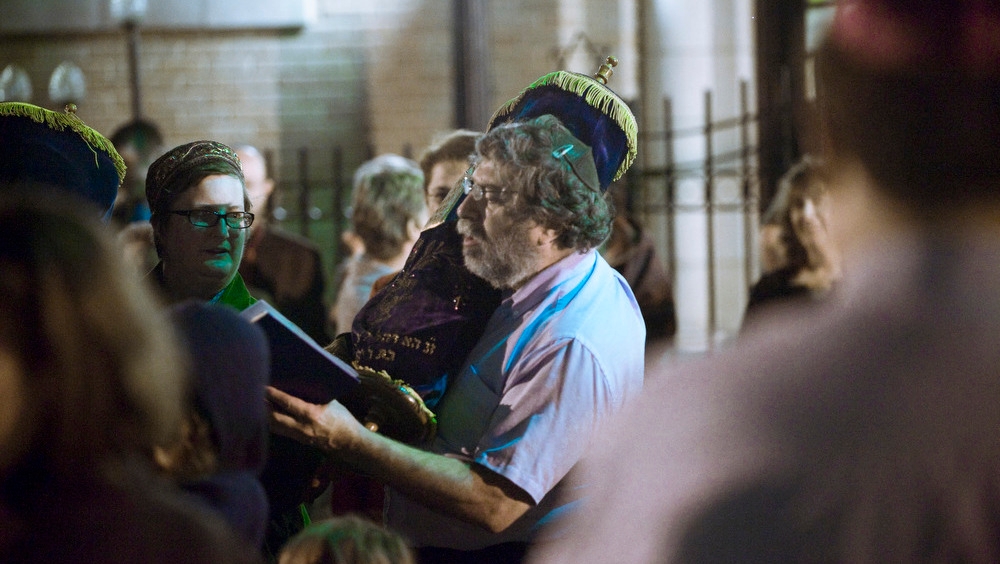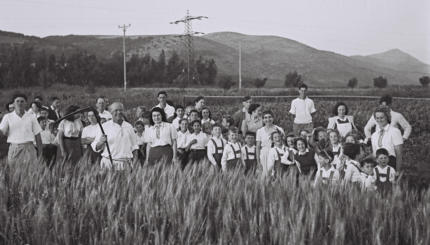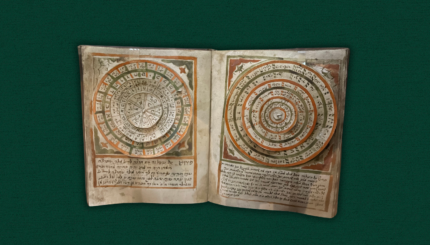In much of the Diaspora (the Jewish communities outside the Land of Israel), Shemini Atzeret (the eighth day of Sukkot) is followed directly by a second special day, Simchat Torah (literally, “joy of the Torah”). In Israel and in most Reform congregations, however, all of the observances for Simchat Torah are held on Shemini Atzeret, combining the two holidays into one day and making them almost indistinguishable. Simchat Torah itself is the celebration dedicated to both completing the yearly cycle of public Torah reading and starting it again.
The first mention of such a cycle appears in the Bible, in Deuteronomy, where Moses instructs the tribe of Levi and the elders of Israel to gather all the people for a public reading from portions of the Torah once every seven years. The need to read the Torah publicly intensified after the destruction of the Second Temple in 70 CE; Jews were dispersed into other parts of the Middle East, into North Africa, and into Europe; and their earlier religious and cultural world became decentralized. While most Jews in the Diaspora now follow one Torah-reading cycle, some communities are on a triennial cycle. (More about that below.)
Dancing and Merriment on Simchat Torah
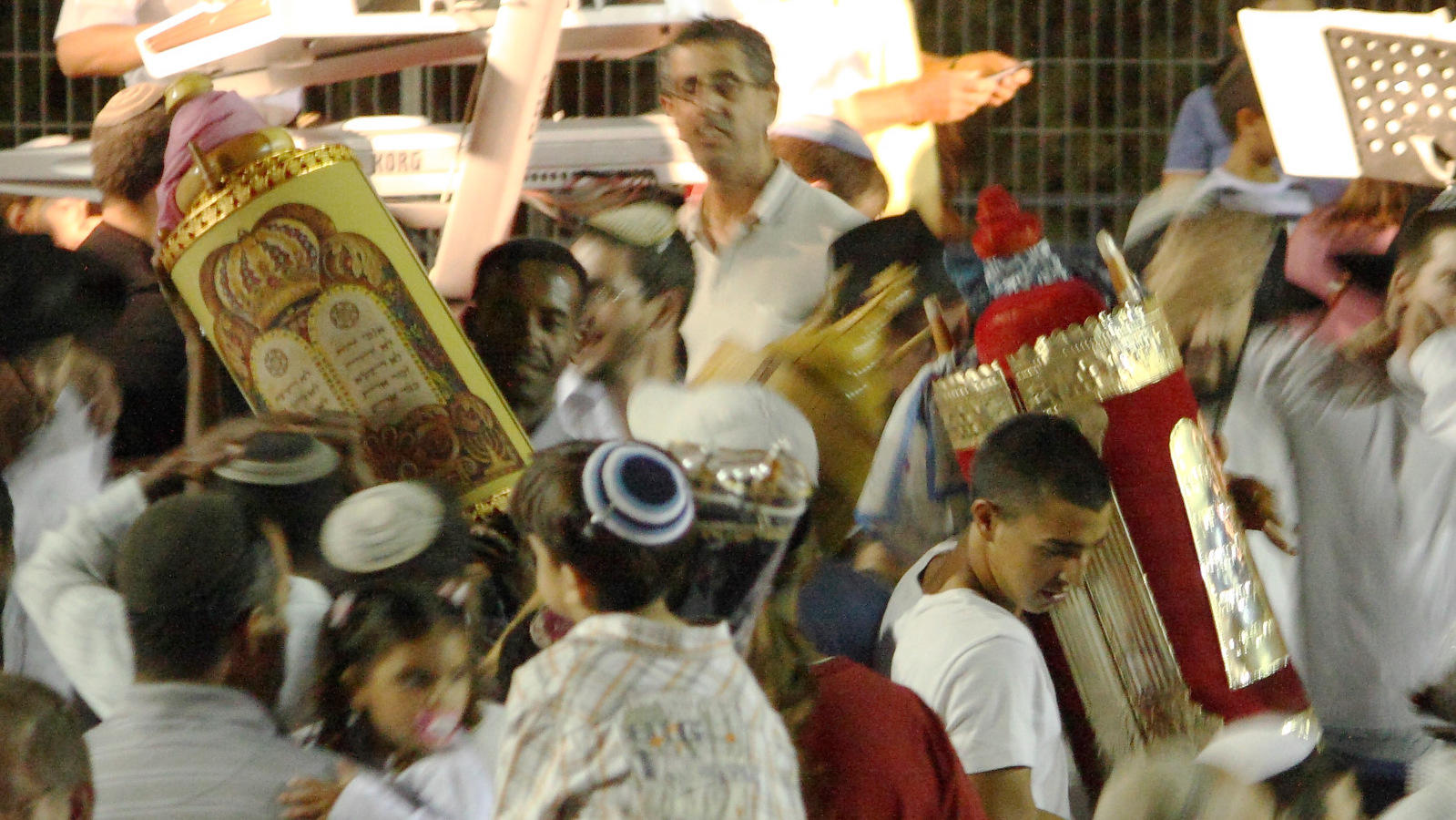
Observance of Simchat Torah begins with the evening service. It provides, in addition to the regular festival liturgy, a special Torah service in which the final Torah portion of the year is read. Before the reading itself begins, selected congregants take all of the Torah scrolls from the ark and parade them around the synagogue. They make seven of these hakafot (circuits), which are performed with joy and accompanied by drinking, singing and dancing.
The festivities for Simchat Torah continue the next morning with seven more hakafot. Children are particularly involved in this merrymaking and are often given paper flags to carry in the processional. The Torah reading that day is drawn from three scrolls. From the first scroll, we read the last portion of Deuteronomy and from the second, the first portion of Genesis. Thus, when we end the Torah with the final book, Deuteronomy, we immediately begin again with the first book, Genesis, to symbolize that Torah never ends and that we never complete our learning. From the third scroll we read the maftir (the passage that concludes the Torah reading). For Simchat Torah, the maftir is from Numbers (Numbers 29:35-30:1), about observing Shemini Atzeret.
With your help, My Jewish Learning can provide endless opportunities for learning, connection and discovery.
Aliyahs for Everyone
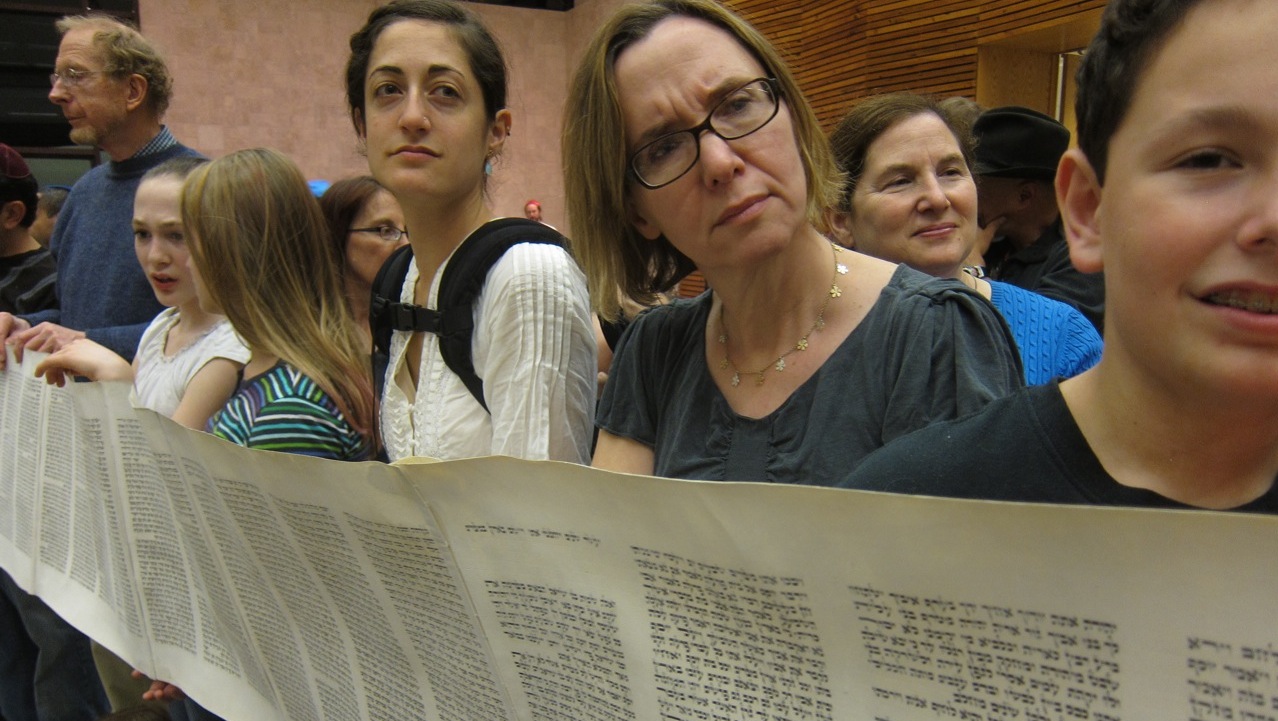
An aliyah (plural, aliyot) is the honor of being called upon to make one set of the blessings said before and after each section of the Torah reading. Customarily, on Simchat Torah, everyone in the congregation receives an aliyah; and so it is common to have both individuals and groups of people called up at once.
Three of the aliyahs are particular honors. The first of these most-honored aliyahs is the next-to-last one for the reading of Deuteronomy that completes the annual cycle of Torah readings. This aliyah is identified as Kol Ha-Ne’arim (literally, “All the Children”), because it is given to a distinguished member of the community, joined on the bimah by all of the children present. The adult honoree holds aloft a prayer shawl forming a canopy above the children. In unison, the honoree and the children say the blessings before and after this reading. Then the entire congregation blesses all the children by reciting the blessing Jacob gave to his grandchildren. In this moment of Simchat Torah, we see a parallel between the unbroken cycle of Torah reading and the never-ending transmission of Torah from generation to generation.
The second very special honor is the final aliyah for this reading from Deuteronomy. The aliyah is designated as the Hatan Torah or Kallat Torah (literally, “Bridegroom of the Torah” or “Bride of the Torah”), and the honor is reserved for someone of great distinction in the community, such as the rabbi.
The third special honor is the aliyah for the Torah reading that begins the new annual cycle — the one at the very beginning of Genesis. The recipient of that aliyah is designated Hatan Bereishit or Kallat Bereishit (literally, “Bridegroom of Genesis” or “Bride of Genesis”). Some congregations have a custom to spread a tallit (prayer shawl) over the Hatan/Kallat Torah and Hatan/Kallat Bereishit, similar to making a canopy over the children.
More About the Torah-Reading Cycle
Because a reference in the Mishnah (the first effort to permanently record Jewish custom and law, compiled in the 3rd century C.E.) supported Deuteronomy’s prescription, we understand that Jews were continuing to read the Torah publicly; and we also know that there were Torah readings for festivals, special Shabbatot (plural of Shabbat) and fast days.
But it was not until the Talmudic era, about the 6th century C.E., that the Jews in the Land of Israel began to read the entire Torah in public and do so until all the Five Books of Moses were completed. At that time, the cycle took three years in a pattern called the Palestinian triennial, beginning the first year with the first book, Genesis, and finishing, at the end of the third year, with the fifth book, Deuteronomy.
The Jews of Babylon, however, followed a different custom, established by the beginning of the 7th century CE, and completed the entire cycle each year, which they did by dividing the Torah into 54 weekly portions. (Because the number of portions exceeds the number of weeks in a given year, more than one portion is read during certain weeks.) In Hebrew, the word for portion is parsha (plural, parshiyot).
In the 19th century, a reintroduction of the Palestinian triennial cycle was attempted at the West End Congregation in London, but was unsuccessful. In the middle of the 20th century, various congregations in the United States (primarily Conservative ones) were seeking ways to modernize the service and also to spend more time on Shabbat on Torah study. They too attempted to revive the Palestinian cycles with the argument that reading only a section of the weekly Torah portion would make Torah study more concentrated and thus enhanced.
The reintroduction failed for two reasons. First, in the pattern of the Palestinian triennial cycle, the weekly reading would have differed from what the rest of the Jewish world was reading. Second, Simchat Torah celebrations would only occur one out of every three years, instead of annually.
Finally, in 1988, the Committee on Jewish Law and Standards of the Conservative Movement passed a legal responsum that put into practice a new American triennial cycle. This new triennial cycle, rather than dividing the entire Torah into thirds, as was done in the Palestinian cycle, divides each of the individual 54 portions into thirds. Therefore, a congregation can be reading within the same portion as those who follow the annual cycle, but will only read one-third of each portion per year. In addition, this pattern enables the congregation to read from Genesis through Deuteronomy each year, providing for an annual celebration of Simchat Torah.
There is an obvious drawback to this system: Only one-third of each conventional Torah portion is actually read per year; and the readings, because incomplete, do not flow smoothly into the portion of the following week. Nonetheless, the vast majority of American Conservative and Reform congregations prefer this new cycle. All Jews in Israel, however, and Orthodox Jews in America continue to follow the annual cycle with the full portion read each week.
Reprinted with permission from Celebrating the Jewish Year (Jewish Publication Society).
aliyah
Pronounced: a-LEE-yuh for synagogue use, ah-lee-YAH for immigration to Israel, Origin: Hebrew, literally, "to go up." This can mean the honor of saying a blessing before and after the Torah reading during a worship service, or immigrating to Israel.
ark
Pronounced: ark, Origin: English, the place in the synagogue where the Torah scrolls are stored, also known as the aron kodesh, or holy cabinet.
Shabbat
Pronounced: shuh-BAHT or shah-BAHT, Origin: Hebrew, the Sabbath, from sundown Friday to sundown Saturday.
Torah
Pronunced: TORE-uh, Origin: Hebrew, the Five Books of Moses.
bimah
Pronounced: BEE-muh, Origin: Hebrew, literally "stage," this is the raised platform in a synagogue from which services are led and the the Torah is read.
